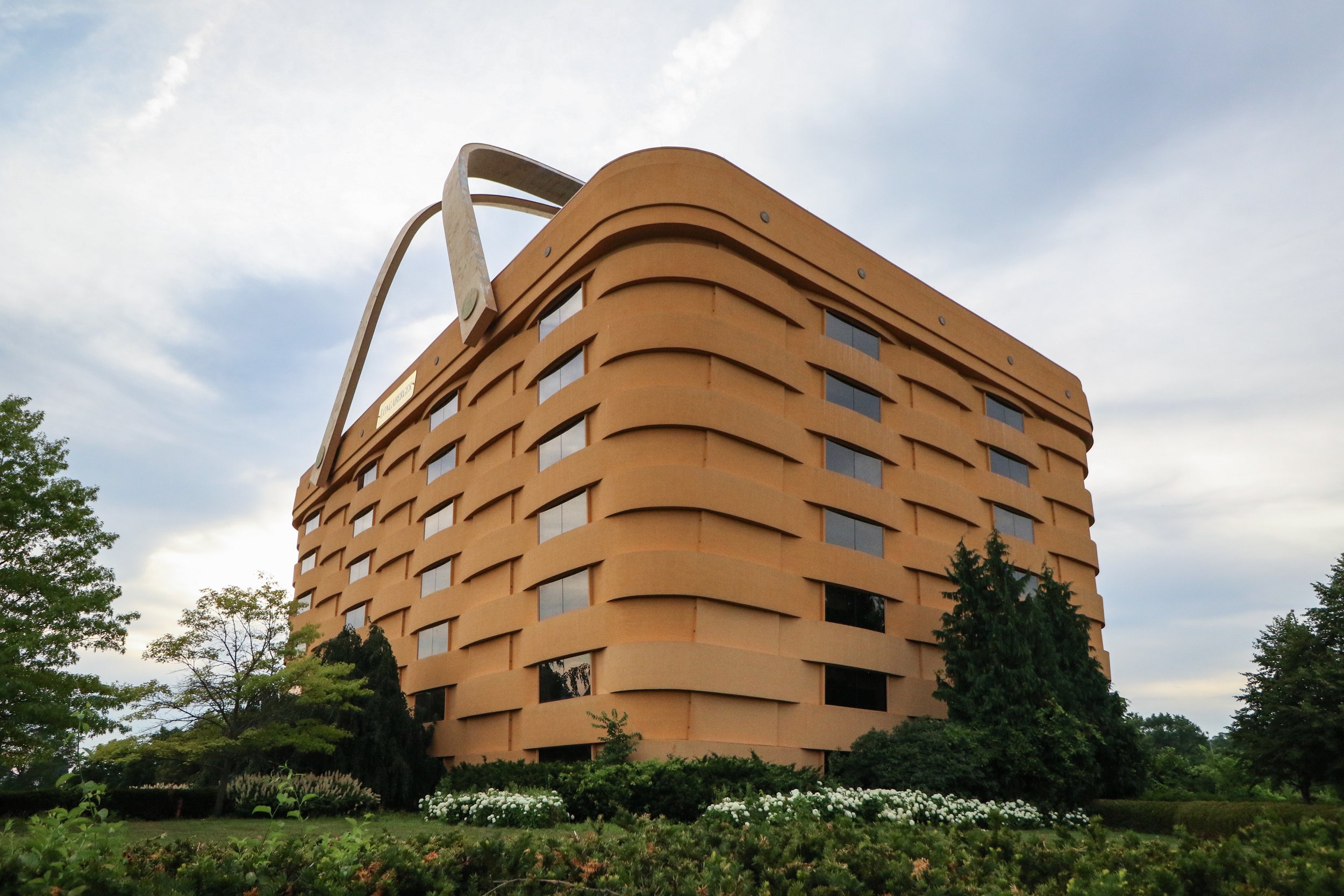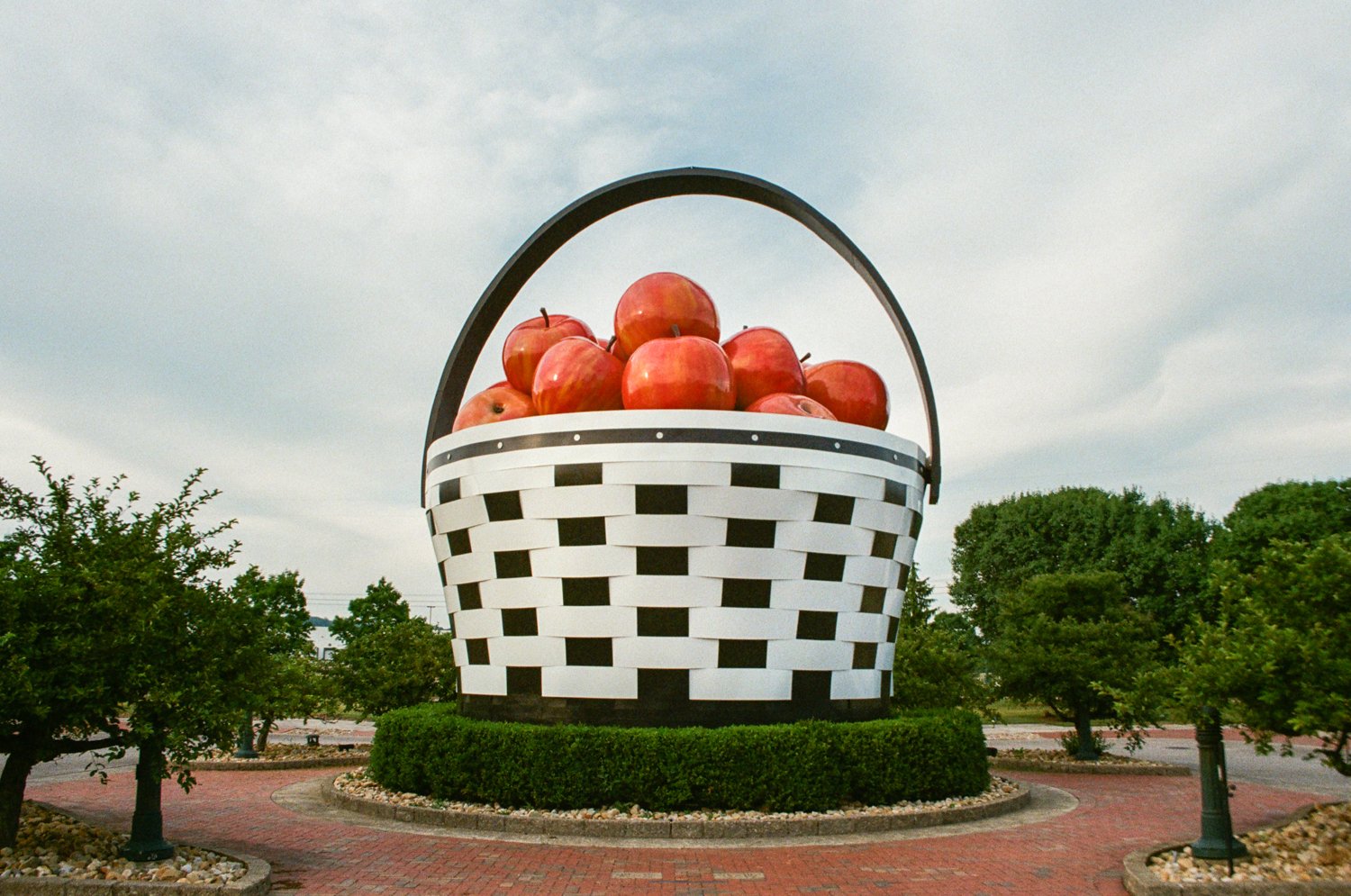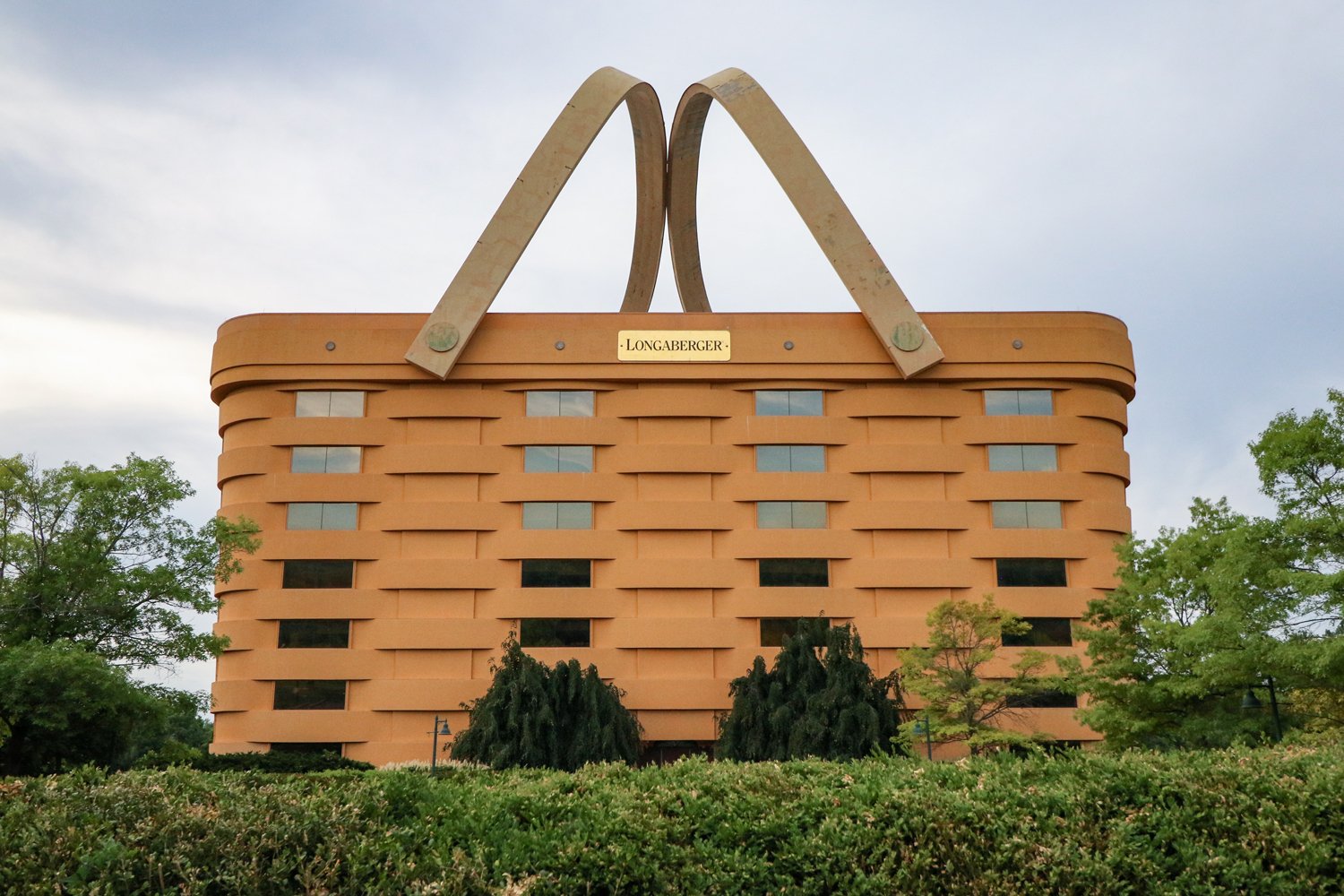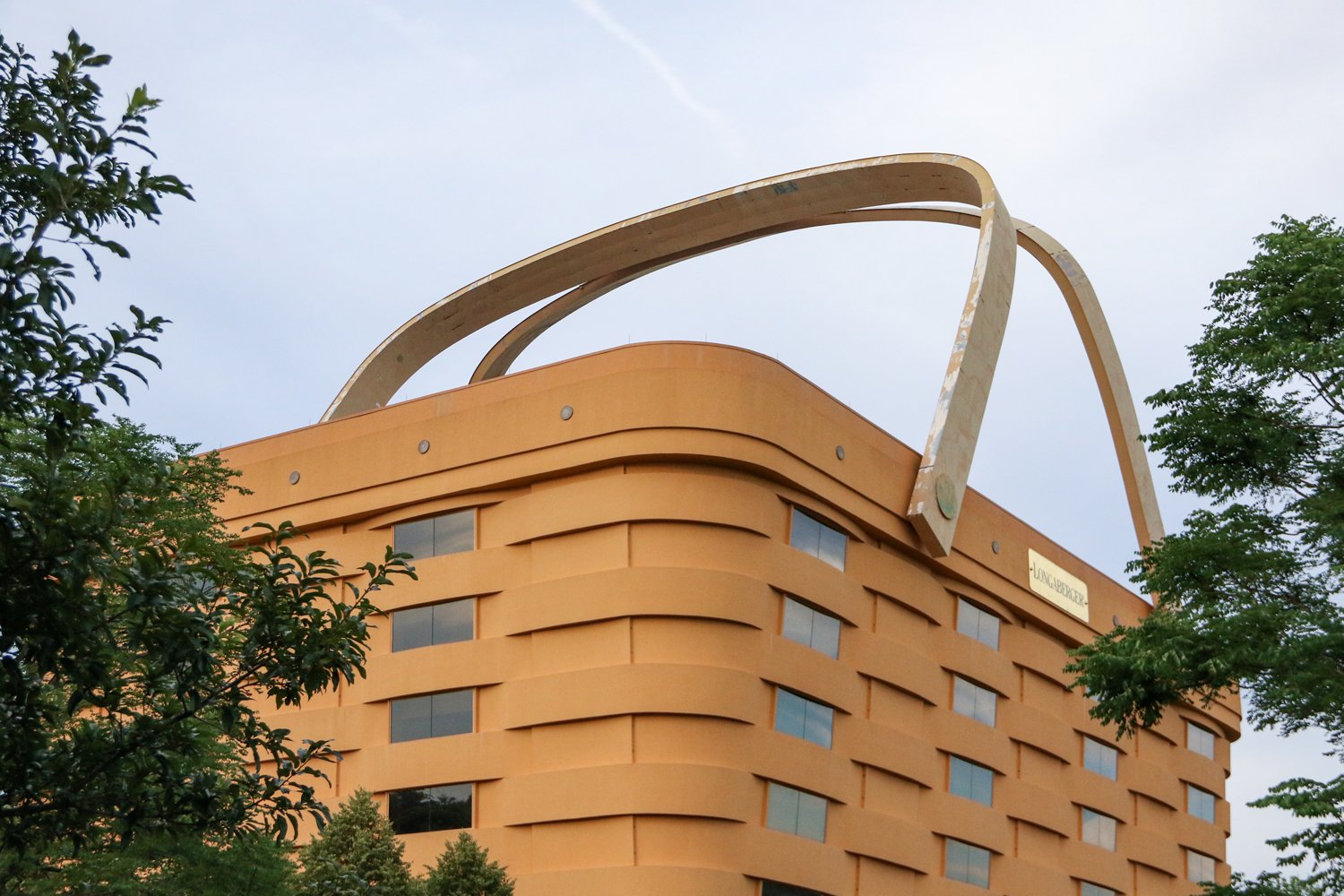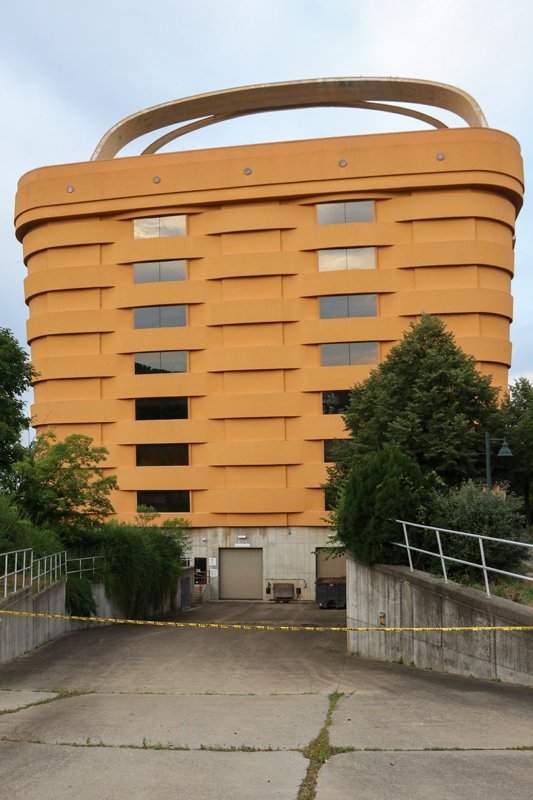The “World’s Largest Basket” and the Languishing Legacy of Longaberger
Back when I was undertaking regular roadtrips throughout Ohio, I’d made this custom Google Map of places I could potentially detour to and photograph. The list featured everything from abandoned stadiums to drive-thru animal safaris and roadside attractions of the “world’s largest” variety. Every now and then, I’ll still find a use for that map—like when Lammi and I wandered our way home from a weekend of “Fear and Loathing” at the “Super Bowl.” On that trip, we stopped by the “World’s Largest Apple Basket” after we’d visited the “World’s Largest Cuckoo Clock.”
The “World’s Largest Apple Basket” of Frazeysburg, Ohio.
The apple basket turned out to be the centerpiece of this abandoned, kitschy tourist complex. While we walked around, it became clear that this desolate outlet mall of sorts had once been part of the whole Longaberger “experience,” which reminded us: we’d be passing by yet another giant basket further down the road. And not just any giant basket, but the “world’s largest basket” which had once been the headquarters of The Longaberger Company.
Former Longaberger Company headquarters. Newark, Ohio. July 2022.
The Longaberger name was once incredibly popular throughout American households. As I first sat down to write this piece and research the company, I initially thought of their products simply as a 1990s fad comparable to Beanie Babies. However, unlike the once immensely popular stuffed animals, the baskets seem to still retain some value—and—at the very least, they’re functional. You could use one to hold a collection of now worthless Beanie Babies, for instance.
Then came the question of whether or not the company had been a scam. Longaberger did use “multi-level marketing” and “direct selling” to move its products, but the internet seems divided. Apparently, yes, the gentler phrases for “pyramid scheme” had been the company’s primary sales method, but it seemed to have been well-intentioned enough. My research wasn’t scientific by any means, but those who’ve shared their thoughts over the years (both online and in archived publications) seem to generally remember the company with a fondness. In fact, the main cloud hanging over the brand’s legacy seems to not be criticism of its products or tactics, but rather, how it all seemed to come crashing down so quickly—a series of events which resulted in the abandonment of its iconic office building.
I grew up with a friend who’s mother seemed to have a Longaberger basket for every possible use. There was one holding umbrellas by the front door, another filled with CD-ROMs next to the computer, one on the kitchen table filled with fruit, and even one designed to sit flush on the staircase. Longaberger wasn’t just a thing in the 1990s, it was the name in home decor for awhile. The company’s roots go back much farther than its late 20th century peak, however.
In 1919, J.W. Longaberger became an apprentice at The Dresden Basket Factory about an hour east of the state capital in Columbus. After years of service at the factory and having become familiar with the trade, J.W. and his wife Bonnie purchased the Dresden operation after it closed. Their son, Dave, would end up running their new venture, starting to market and sell J.W.’s baskets in 1973. Eventually, their sales strategy shifted to a multi-level marketing model. While the baskets were manufactured by trained artisans, sales associates moved product via home shows, house parties, and recruiting acquaintances. Think Tupperware, but with products touted for having been handmade in the American heartland.
By 1997, thanks to Dave Longaberger’s leadership, the brand had evolved into a Fortune 500 company serving a consumer base that ranged from casual buyers to fervent collectors. To commemorate the success, and consolidate operations, a new headquarters was opened in nearby Newark, Ohio. A perfect example of Novelty Architecture—when buildings are designed to physically mirror their purpose—the seven-story, 180,000-square-foot office building resembled a typical Longaberger basket. The “handles” were even outfitted with heating mechanisms to combat ice accumulation. In 2000, the company reported profits in excess of $1 Billion and even had its products handed out to winners at the 72nd Academy Awards (“American Beauty” won Best Picture that year and its lead, Kevin Spacey, took home Best Actor).
By the time of the Oscars and billion dollar profits, Tami Longaberger was in charge. The eldest daughter of Dave, she’d come to assume leadership of the company after her father retired in 1998. Dave had remained chairman of the board for a time, but passed away from kidney cancer in the spring of 1999 at the age of 64. This was also when the business’ fortunes began to shift dramatically. Longtime Longaberger fans have offered theories over the years as to what caused the company’s decline, but the reality may just boil down to the fact that tastes changed. Longaberger baskets had their moment in the home decor sun, but they seemed to have simply run their course.
The Newark Advocate lays it all out in detail, but the gist is this: layoffs began in 2003 and continued in the following years as demand for the baskets sharply decreased. Additionally, some manufacturing was moved overseas. This undermined one of the company’s key marketing strategies: the notion that the baskets were “made in the USA.” While Tami and the company announced that they’d be shifting manufacturing back to the States in 2012, the writing had already been on the wall for quite some time. Layoffs continued, further pay cuts were announced, demand kept falling, and the company came under the umbrella of a larger corporate entity. In 2015, Tami Longaberger resigned as CEO and by July 2016, the basket building was abandoned.
Six years later, in the summer of 2022, this is how it looked:
The landmark building that had once been featured on so many lists as a unique roadside attraction (and in the books that predated the proliferation of the internet) came into the sights of the local government after it was emptied. There was an issue regarding unpaid property taxes before the structure was sold to a developer in 2017. Shortly after the sale, plans for converting the structure into a luxury hotel and convention center never materialized.
The basket building featured on the cover of 2008’s Roadside Americana by Eric Peterson.
In 2019, a tour of the building was held. Atlas Obscura would report on the event’s positive reception, as well as, a historic preservation group’s efforts to save the building. There was even an attempt to get the structure added to the National Register of Historic Places.
The giant basket isn’t the only vestige of The Longaberger Company’s bygone prominence in the surrounding area, though. Down the road in Frazeysburg, the former factory and tourist complex once known as “The Longaberger Homestead” also sits empty. This is where the “world’s largest apple basket” remains and where manufacturing tours were once given. Although the buildings are shuttered and a little worse for wear, the apple basket itself was apparently repainted and restored in recent years. Over in nearby Dresden, where the company was founded, there’s a memorial to Dave Longaberger near “The World’s Largest Basket.” That one—apparently a giant, real basket—is often billed with the label even if the former headquarters building in Newark seems to often get credited with the title too.
Tours of the basket building and the nearby manufacturing facilities were once a hallmark of the brand and a vacation pilgrimage for many midwesterners.
The Longaberger Company still exists today, although well diminished from its 2000s peak. After completely ceasing operations in 2018, the brand was relaunched in 2019 with the assistance of Tami Longaberger. The company still offers handmade baskets in addition to a selection of curated home goods and accessories. As of this publishing, however, the iconic building along the Ohio roadside is still abandoned. There’s a plaque embedded in the sidewalk out front, next to a pair of footprints cast in the concrete reading:
Dave Longaberger’s footprints were much like anyone else’s.
The difference was where he went and what he did when he got there.
Whether it was driving a bread truck, running a diner, managing a grocery, or building a business based on his dad’s baskets, Dave lived life his way… and succeeded even when others scoffed and said, “Dave, it can’t be done.”
Thank you Dave for teaching us the impossible is always possible - if we believe in our dreams… if we have the courage to take the first steps.
Per the website of the revived Longaberger Company: folks can “join the family” once again, becoming “stylists” who use social media to sell products via referrals and “social shopping.”
For other stories of abandoned and forgotten places, check out the Urban Exploration series.
Since 2007, the content of this website (and its former life as Queen City Discovery) has been a huge labor of love.
If you’ve enjoyed stories like The Ghost Ship, abandoned amusement parks, the Cincinnati Subway, Fading Ads, or others over the years—might you consider showing some support for future projects?
